A small Japanese force occupied the islands of Attu and Kiska, where the remoteness of the islands and the challenges of weather and terrain delayed a larger US-Canadian force sent to eject them for nearly a year.
The islands' strategic value was their ability to control Pacific transportation routes, which is why US General Billy Mitchell stated to the US Congress in 1935, "I believe that in the future, whoever holds Alaska will hold the world. I think it is the most important strategic place in the world." The Japanese reasoned that control of the Aleutians would prevent a possible US attack across the Northern Pacific. Similarly, the US feared that the islands would be used as bases from which to launch aerial assaults against the West Coast.
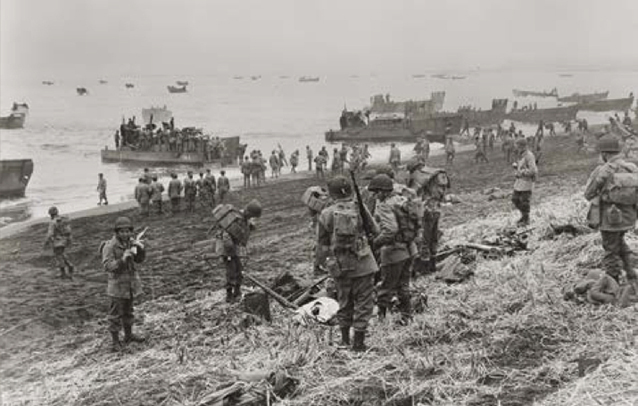
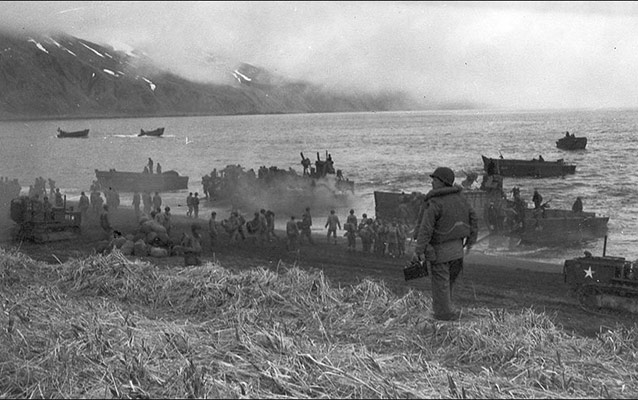
A battle to reclaim Attu was launched on May 11, 1943 and completed following a final Japanese banzai charge on May 29. On 15 August 1943, an invasion force landed on Kiska in the wake of a sustained three-week barrage, only to discover that the Japanese had withdrawn from the island on July 29.
The campaign is known as the "Forgotten Battle", due to its being overshadowed by the simultaneous Guadalcanal Campaign. In the past, many Western military historians believed it was a diversionary or feint attack during the Battle of Midway , meant to draw out the US Pacific Fleet from Midway Atoll, as it was launched simultaneously under the same commander, Isoroku Yamamoto. However, historians Jonathan Parshall and Anthony Tully have argued against this interpretation, stating that the Japanese invaded the Aleutians to protect their northern flank, and did not intend it as a diversion.

Before Japan entered World War II, its Navy had gathered extensive information about the Aleutians , but it had no up-to-date information regarding military developments on the islands. Admiral Isoroku Yamamoto provided the Japanese Northern Area Fleet, commanded by Vice-Admiral Boshiro Hosogaya, with a force of two non-fleet aircraft carriers, five cruisers, twelve destroyers, six submarines, and four troop transports, along with supporting auxiliary ships.
With that force, Hosogaya was first to launch an air attack against Dutch Harbor, then follow with an amphibious attack upon the island of Adak, 480 miles to the west. Hosogaya was instructed to destroy whatever American forces and facilities were found on Adak - the Japanese did not know the island was undefended. Hosogaya's troops were to return to their ships and become a reserve for two additional landings: the first on Kiska , 240 miles west of Adak, the other on the Aleutians' westernmost island, Attu, 180 miles west from Kiska.
Because United States Naval Intelligence had broken the Japanese naval codes , Admiral Chester Nimitz had learned by May 21 of Yamamoto's plans, including the Aleutian diversion, the strength of both Yamamoto's and Hosogaya's fleets, and that Hosogaya would open the fight on June 1 or shortly thereafter.
| Aleutian Islands Campaign | |||||||
|---|---|---|---|---|---|---|---|
| Part of the American Theater and the Pacific Theater of World War II | |||||||
 American troops hauling supplies on Attu in May 1943 through Jarmin pass. Their vehicles could not move across the island's rugged terrain. | |||||||
| |||||||
| Belligerents | |||||||
| Commanders and leaders | |||||||
| Strength | |||||||
| 144,000 | 8,500 | ||||||
| Casualties and losses | |||||||
| 1,481 killed 225 aircraft destroyed 640 missing 3,416 wounded 8 captured US Navy vessels heavily damaged USS Salt Lake City (CA-25) USS Abner Read (DD-526) US Navy vessels lost USS Worden (DD-352) USS S-27 (SS-132) USS Grunion (SS-216) | 4,350 killed 28 captured 7 warships sunk 9 cargo transport ships sunk | ||||||
| 1 civilian killed, 46 captured | |||||||
As of June 1, 1942, United States military strength in Alaska stood at 45,000 men, with about 13,000 at Cold Bay (Fort Randall) on the tip of the Alaskan Peninsula and at two Aleutian bases: the naval facility at Dutch Harbor on Unalaska Island , 200 miles west of Cold Bay, and the recently built Fort Glenn Army Airfield 70 miles west of the naval station on Umnak Island. Army strength, less air force personnel, at those three bases totaled no more than 2,300, composed mainly of infantry, field and antiaircraft artillery troops, and a large construction engineer contingent, which was used in the construction of bases.
The Army Air Force's Eleventh Air Force consisted of 10 B-17 Flying Fortress heavy bombers and 34 B-18 Bolo medium bombers at Elmendorf Airfield, and 95 P-40 Warhawk fighters divided between Fort Randall AAF at Cold Bay and Fort Glenn AAF on Umnak. The naval commander was Rear Admiral Robert A. Theobald , commanding Task Force 8 afloat, who as Commander North Pacific Force (ComNorPac) reported to Admiral Nimitz in Hawaii. Task Force 8 consisted of five cruisers , thirteen destroyers, three tankers, six submarines , as well as naval aviation elements of Fleet Air Wing Four.
When the first signs of a possible Japanese attack on the Aleutians were known, the Eleventh Air Force was ordered to send out reconnaissance aircraft to locate the Japanese fleet reported heading toward Dutch Harbor and attack it with bombers, concentrating on sinking Hosogaya's two aircraft carriers. Once the enemy planes were removed, Naval Task Force 8 would engage the enemy fleet and destroy it. On the afternoon of 2 June, a naval patrol plane spotted the approaching Japanese fleet, reporting its location as 800 miles southwest of Dutch Harbor. Eleventh Air Force was placed on full alert. Shortly thereafter bad weather set in, and no further sightings of the fleet were made that day.
----
According to Japanese intelligence, the nearest field for land-based American aircraft was at Fort Morrow AAF on Kodiak, more than 600 miles away, and Dutch Harbor was a sitting duck for the strong Japanese fleet, carrying out a coordinated operation with a fleet that was to capture Midway Island.
Making use of weather cover, the Japanese first raided the naval base at Dutch Harbor on June 3, 1942. The striking force was composed of Nakajima B5N 2 "Kate" torpedo bombers from the carriers Junyō and Ryūjō . However, only half of the striking force reached their objective. The rest either became lost in the fog and darkness and crashed into the sea or returned to their carriers. Seventeen Japanese planes found the naval base, the first arriving at 05:45. As the Japanese pilots looked for targets to engage, they came under intense anti-aircraft fire and soon found themselves confronted by Eleventh Air Force fighters sent from Fort Glenn Army Air Field on Umnak. Startled by the American response, the Japanese quickly released their bombs, made a cursory strafing run, and left to return to their carriers. As a result, they did little damage to the base.
On June 4, the Japanese returned to Dutch Harbor. This time the Japanese pilots were better organized and prepared. When the attack ended that afternoon Dutch Harbor oil storage tanks were burning, the hospital partly demolished, and a beached barracks ship damaged. Although American pilots eventually located the Japanese carriers, attempts to sink the ships failed due to bad weather setting in that caused the US pilots to completely lose contact with the Japanese fleet. However, the foul weather in turn caused the Japanese to cancel plans to invade Adak with 1,200 men.
----
The Japanese invasions of Kiska on June 6 and Attu on June 7 initially met little resistance from the local Aleuts . Much of the native population of the islands had been forcibly evacuated by the US military before the invasion and interned in camps in the Alaska Panhandle .
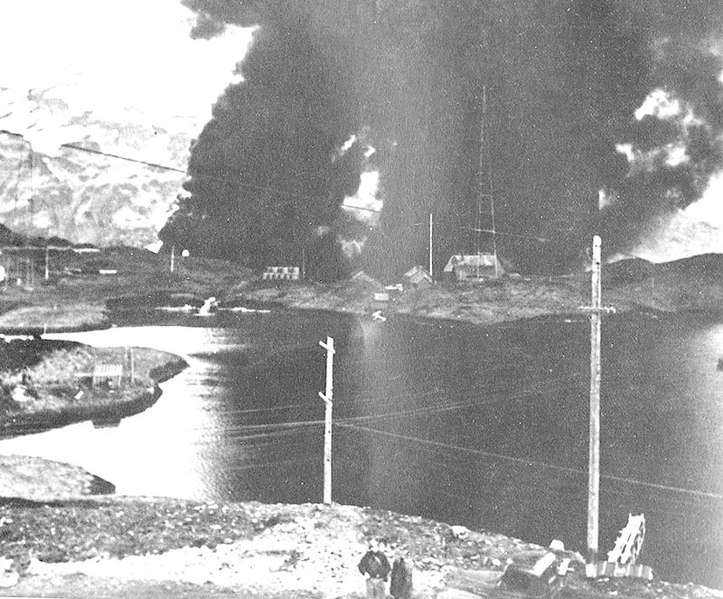
In August 1942, the US Army established an air base on Adak Island and began bombing Japanese positions on Kiska. US Navy submarines and surface ships also began patrolling the area. Kiska Harbor was the main base for Japanese ships in the campaign and several were sunk there, some by warships but mostly in air raids.
On 5 July, the submarine Growler, under command of Lieutenant Commander Howard Gilmore , attacked three Japanese destroyers off Kiska. He sank one and heavily damaged the others, killing or wounding 200 Japanese sailors. Ten days later, Grunion was attacked by three Japanese submarine chasers in Kiska Harbor, with two of the patrol craft sunk and one other damaged. On 12 May 1943, the Japanese submarine I-31 was sunk in a surface action with the destroyer Edwards 8.0 km northeast of Chichagof Harbor.

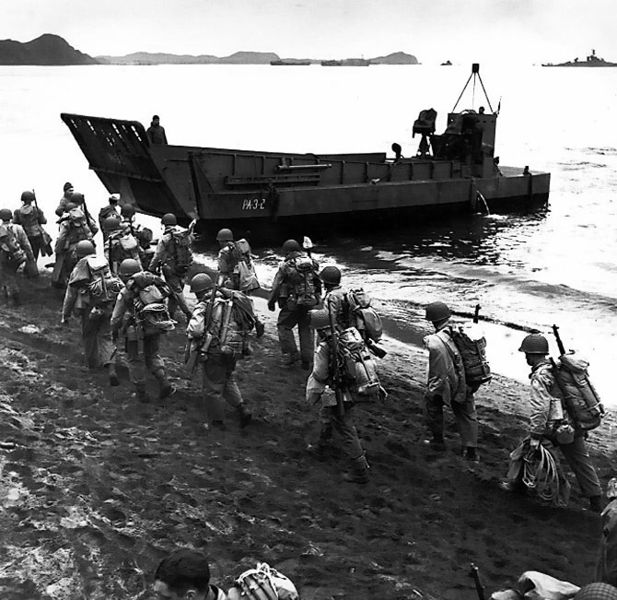
The heavy cruiser Salt Lake City under fire off the Komandorski Islands.
A cruiser and destroyer force under Rear Admiral Charles "Soc" McMorris was assigned to eliminate the Japanese supply convoys. They met the Japanese fleet in the naval Battle of the Komandorski Islands in March 1943. One American cruiser and two destroyers were damaged, with seven US sailors killed. Two Japanese cruisers were damaged, with 14 men killed and 26 wounded. Japan thereafter abandoned all attempts to resupply the Aleutian garrisons by surface vessels, and only submarines would be used.
On 11 May 1943, American forces commenced an operation to recapture Attu. The invasion force included scouts recruited from Alaska, nicknamed Castner's Cutthroats. A shortage of landing craft, unsuitable beaches, and equipment that failed to operate in the appalling weather made it difficult for the Americans to exert force against the Japanese.
----
Adding to problems for the US forces, soldiers suffered from frostbite because essential cold weather supplies could not be landed, nor could soldiers be relocated to where needed because vehicles would not operate on the tundra . The Japanese defensive strategy to the American attacks included Colonel Yasuyo Yamasaki not to have his forces defend against the Americans landings. The Japanese instead dug into high ground far from the shore; this resulted in fierce combat, with a total of 3,929 US casualties; 580 men were killed, 1,148 were wounded, with another 1,200 men suffering severe injuries from the cold weather. In addition, 614 Americans died from disease, and 318 from miscellaneous causes, mainly Japanese booby traps or friendly fire.
On May 29, 1943, without warning the remainder of Japanese forces attacked near Massacre Bay. This was recorded as one of the largest banzai charges of the Pacific campaign. Led again by Colonel Yamasaki, the attack penetrated so deep into US lines that Japanese soldiers encountered rear-echelon units of the Americans. After furious, brutal, often hand-to-hand combat , the Japanese force was virtually exterminated. Only 28 Japanese soldiers were taken prisoner, none of them officers. American burial teams counted 2,351 Japanese dead, but it was thought that hundreds more Japanese bodies had been buried by bombardment during the battle.


On 15 August 1943, an invasion force of 34,426 Canadian and American troops landed on Kiska. Castner's Cutthroats were part of the force, but the invasion consisted mainly of units from the US 7th Infantry Division. The force also included about 5,300 Canadians, mostly from the 13th Canadian Infantry Brigade of the 6th Canadian Infantry Division, and the 1st Special Service Force , later known as the "Devil's Brigade," a 2,000 man Canadian-American commando unit formed in 1942 in Montana and trained in winter warfare techniques.
The Brigade included three regiments: the 1st was to go ashore in the first wave at Kiska Harbor, the 2nd was to be held in reserve to parachute where needed, and the 3rd was to land on the north side of Kiska on the second day of the assault. The 87th Regiment of the 10th Mountain Division , the only major US force specifically trained for mountain warfare, was also part of the operation. The only casualties were from friendly fire when a Canadian soldier mistakenly shot at American forces, starting a shooting match in the dense fog.
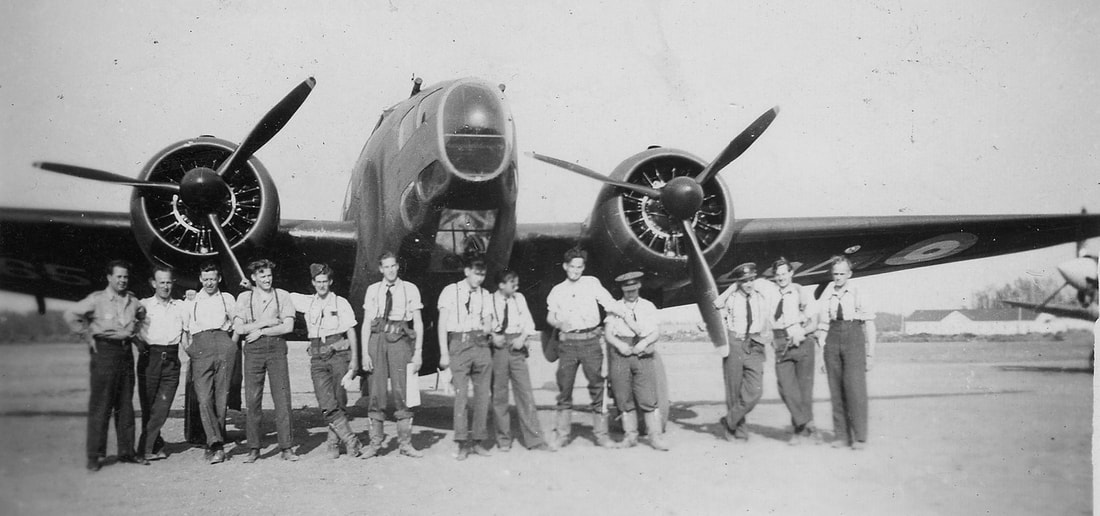
Royal Canadian Air Force No. 111 and No. 14 Squadrons saw active service in the Aleutian skies and scored at least one aerial kill on a Japanese aircraft. Additionally, three Canadian armed merchant cruisers and two corvettes served in the Aleutian campaign but did not encounter enemy forces.
The invaders landed to find the island abandoned; the Japanese forces had left two weeks earlier. Under the cover of fog, the Japanese had successfully removed their troops on 28 July. Despite US military command having access to Japanese ciphers and having decoded all the Japanese naval messages, the Army Air Force chose to bomb abandoned positions for almost three weeks. The day before the withdrawal, the US Navy fought an inconclusive and possibly meaningless Battle of the Pips 130 km to the west.
Although the Japanese troops had gone, Allied casualties on Kiska numbered 313. They were the result of friendly fire, booby traps, disease or frostbite. Like Attu, Kiska offered an extremely hostile environment.

Although plans were drawn up for attacking northern Japan, they were not executed. Over 1,500 sorties were flown against the Kuriles before the end of the war, including the Japanese base of Paramushir , diverting 500 Japanese planes and 41,000 ground troops.
The battle also marked the first time Canadian conscripts were sent to a combat zone in World War II. The government had pledged not to send draftees "overseas", which it defined as being outside North America. The Aleutians were considered to be North American soil, thus enabling the Canadian government to deploy conscripts without breaking its pledge. There were cases of desertion before the brigade sailed for the Aleutians. In late 1944, the government changed its policy on draftees and sent 16,000 conscripts to Europe to take part in the fighting.
The battle also marked the first combat deployment of the 1st Special Service Force , though they also did not see any action.

Captured Japanese Zero. It was captured intact by US forces in July 1942 on Akutan Island, after the Dutch Harbor Attack and became the first flyable Zero acquired by the United States during the Second World War. It was repaired and made its first test flight in the US on 20 September 1942
In the summer of 1942, the Americans recovered the Akutan Zero, an almost intact Mitsubishi A6M2 Zero fighter. This enabled the Americans to test-fly the Zero and contributed to improved fighter tactics later in the war.
During the campaign, two cemeteries were established on Attu to bury those killed in action: Little Falls Cemetery, located at the foot of Gilbert Ridge, and Holtz Bay Cemetery, which held the graves of Northern Landing Forces. After the war, the frozen tundra began to take back the cemeteries, so in 1946 all American remains were relocated as directed by the soldier's family or to Fort Richardson near Anchorage, Alaska. On May 30, 1946, a Memorial Day address was given by Captain Adair with a 21-gun salute and the sounding of Taps. The Decoration of Graves was performed by Chaplains Meaney and Insko.
The 2006 documentary film Red White Black & Blue features two veterans of the Attu Island campaign, Bill Jones and Andy Petrus. It is directed by Tom Putnam and debuted at the 2006 Locarno International Film Festival in Locarno , Switzerland on August 4, 2006.
Dashiell Hammett spent most of World War II as an Army sergeant in the Aleutian Islands, where he edited an Army newspaper. He came out of the war suffering from emphysema . As a corporal in 1943, he co-authored The Battle of the Aleutians with Cpl. Robert Colodny under the direction of Infantry Intelligence Officer Major Henry W. Hall.
Many of the United States locations involved in the campaign, either directly or indirectly, have been listed on the National Register of Historic Places , and several have been designated National Historic Landmarks. The battlefield on Attu and the Japanese occupation site on Kiska are both National Historic Landmarks, and are included in the World War II Valor in the Pacific National Monument . Surviving elements of the military bases at Adak , Umnak, and Dutch Harbor are National Historic Landmarks. The shipwrecked SS Northwestern, badly damaged during the attack on Dutch Harbor, is listed on the National Register, as is a crash-landed B-24D Liberator on Atka Island.

Ei kommentteja:
Lähetä kommentti
Any explosive ammunition or empty cores, you can put in this.